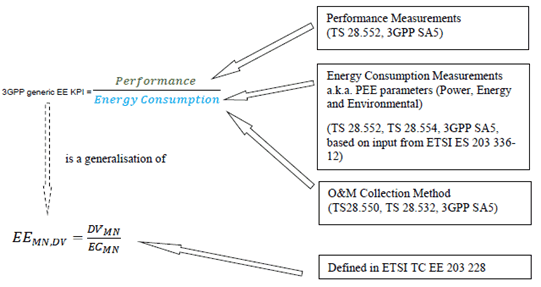Content for TR 22.882 Word version: 19.3.0
A Existing energy efficiency standardisation
A.1 Overview of existing energy efficiency standardisation
A.2 Energy efficiency KPIs
A.3 Summary of existing energy efficiency standards
$ Change history
A Existing energy efficiency standardisation p. 40
A.1 Overview of existing energy efficiency standardisation p. 40
In ETSI, GSMA and 3GPP, there were many reports, studies, specifications related to energy efficiency. And now there are also ongoing 3GPP R18 studies on energy efficiency in both SA5 and RAN.
In ETSI, existing specifications cover several aspects of energy efficiency, which include energy efficiency metrics and measurement methods for mobile core equipment, metrics and methods to measure energy performance of Mobile Radio Access Networks, measurement and monitoring of power, energy and environmental parameters for ICT equipment in telecommunications. [2] [3]
GSMA has done lots of work in assessing energy consumption in different fields within a communication system. In "Going green: benchmarking the energy efficiency of mobile", GSMA states that 73% of the energy of the participating operators is consumed in the radio access network (RAN). The network core (13%), owned data centres (9%) and other operations (5%) account for the rest. [4] The statistics show that energy efficiency is an end-to-end issue.
In 3GPP, energy efficiency has been studied in SA, SA5 and RAN. SA have studied system requirements and principles and provided an Energy Efficiency Control Framework. [5] SA5 has specified concepts, use cases, requirements and solutions for energy efficiency assessment and optimization for energy saving, as well as Energy Efficiency (EE) KPIs. [6] [7] RAN EE study has concentrated on the definition of network energy consumption models, evaluation methodology and KPIs, also studied and identified techniques on the gNB and UE sides to improve network energy savings in terms of both BS transmission and reception. [8]
A.2 Energy efficiency KPIs p. 40
3GPP Energy Efficiency KPI definitions are under SA5 (Telecom Management) responsibility. They are based on measurements collected on RAN or CN network elements / network functions via OA&M. The KPI calculation is a generalisation of the work in ETSI TC EE. Figure A.2-1 below shows the KPI derivation with notes to the source specifications.

A.3 Summary of existing energy efficiency standards p. 40
Table A.3-1 below shows the standards relevant to the present document with a synopsis taken from the Scope clause of the standard.
| SDO | Group | Standard | Summary |
|---|---|---|---|
| 3GPP | SA | TR 21.866: "Study on Energy Efficiency Aspects of 3GPP Standards" [5] | Identifies and studies the key issues and the potential solutions in defining Energy Efficiency Key Performance Indicators and the Energy Efficiency optimization operations in existing and future 3GPP networks. |
| 3GPP | SA5 | TS 28.310: "Management and orchestration; Energy efficiency of 5G" [6] | Specifies concepts, use cases, requirements and solutions for the energy efficiency assessment and optimization for energy saving of 5G networks. |
| 3GPP | SA5 | TS 28.552: "Management and orchestration; 5G performance measurements" [11] | Specifies the performance measurements for 5G networks including network slicing. Performance measurements for NG-RAN are defined in this document, and some L2 measurement definitions are inherited from TS 38.314. The performance measurements for 5GC are all defined in this document. Related KPIs associated with those measurements are defined in TS 28.554. |
| 3GPP | SA5 | TS 28.554: "Management and orchestration; 5G end to end Key Performance Indicators (KPI)" [12] | Specifies end-to-end Key Performance Indicators (KPIs) for the 5G network and network slicing |
| 3GPP | SA5 | TS 28.622: "Telecommunication management; Generic Network Resource Model (NRM) Integration Reference Point (IRP); Information Service (IS)" [13] | Specifies the Generic network resource information that can be communicated for telecommunication network management purposes, including management data about energy efficiency |
| 3GPP | SA5 | TR 28.813: "Management and orchestration; Study on new aspects of Energy Efficiency (EE) for 5G" [7] | Investigates the opportunities for defining new Energy Efficiency (EE) KPIs and new Energy Saving (ES) solutions. |
| 3GPP | RAN1 | TR 38.864: "Study on network energy savings for NR" [8] | Investigates network energy consumption modelling, techniques for network energy saving, evaluation of gains and impact. |
| ETSI | TC EE | ETSI ES 203 228: "Environmental Engineering (EE); Assessment of mobile network energy efficiency" [3] | Defines the topology and level of analysis to assess the energy efficiency of mobile networks (excluding terminal) |
| ETSI | TC EE | ETSI ES 202 336-1: "Environmental Engineering (EE); Monitoring and Control Interface for Infrastructure Equipment (Power, Cooling and Building Environment Systems used in Telecommunication Networks) Part 1: Generic Interface" [9] | Defines monitoring and control of Infrastructure Environment i.e. power, cooling and building environment systems for telecommunication centres and access network locations. |
| ETSI | TC EE | ETSI ES 202 336-12: "Environmental Engineering (EE); Monitoring and control interface for infrastructure equipment (power, cooling and building environment systems used in telecommunication networks); Part 12: ICT equipment power, energy and environmental parameters monitoring information model" [10] | Defines measurement and monitoring of power, energy and environmental parameters for ICT equipment in telecommunications or datacenter or customer premises |